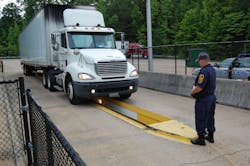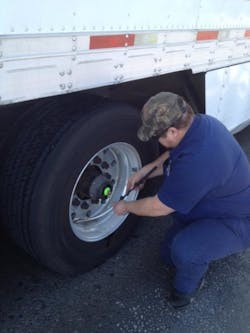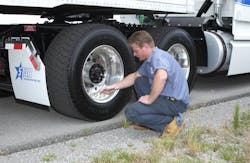With the annual 72-hour Roadcheck inspection blitz overseen by the Commercial Vehicle Safety Alliance's (CVSA) set to kick off June 6 through 8 this year – just a scant few days away – now’s the time to make sure one last time that you’ve got all the components of your big rig in tip-top shape, especially your tires.
Last year, CVSA’s annual Roadcheck effort put a particular focus on tire and wheel safety. For the 2016 Roadcheck campaign, tire and wheel violations accounted for 18.5% of the total percentage of out of service (OOS) violations. Overall, in the U.S., tire violations represent 13.7% of total OOS vehicle violations, CVSA said.
While this year’s event will place special emphasis on cargo securement [you can read more on that by clicking here] tires are usually one of the first items a law enforcement officer will check during a roadside inspection [as this story illustrates] so it behooves a truck driver to ensure they properly inflated and not damaged.
CVSA explained that when roadside inspectors check tires, they measure tire tread depth, check tire pressure, check to ensure no solid objects are lodged between dual tires and examine overall tire condition to make sure no deep cuts or bulges were found on any tire sidewall.
To help fleets and owner-operators alike ensure their tires are up to snuff, Al Cohn, director of new market development and engineering for Pressure Systems International (P.S.I.), has some advice to offer.“Roadside inspection of trailers equipped with automatic tire inflation systems (ATIS) requires special consideration,” he explained to American Trucker, noting that such technology is now found on a majority of trailers.
“Trailer tires are still the most neglected tire wheel position,” Cohn added. “Inside dual tires can be 20 or even 30 psi [pounds per square inch] less [in inflation levels] than the outside duals, since they are so infrequently inspected.”
He believes tire pressure gauges are a major reason for that disparity because many gauges are inaccurate.
“Brand new, out of the box, regardless of manufacturer, the most common stick gauges are only plus or minus 3 psi,” Cohn stressed. “But just dropping [tire inflation] gauges on hard concrete can reduce the accuracy down to plus or minus 5 psi.”
For a roadside inspector to check actual tire pressure requires unscrewing the hand tight hose connected to the rotary union, Cohn said. Using a calibrated stick gauge over the end of the hose will allow the inspector to determine the exact tire pressure, he noted.
“However, many inspectors have been informed not to unscrew any hoses,” Cohn pointed out. “If that is the case, and the trailer is outfitted with ATIS, the inspector must rely on the warning light usually located on the front of the box trailer that the driver can see in his side mirror.”
If that light is on, then air is flowing into a tire with low inflation levels. For tanker trailers, the warning light is usually located on the left side near the rear of the trailer that the driver can still see in his side mirror. If the warning light is NOT illuminated, then the tires are all at or slightly above the specified tire pressure.
But if a trailer is not equipped with ATIS, the tire inspection process involves removing any tire valve cap to manually check the tire pressure using a calibrated pressure gauge.Regardless whether a trailer is equipped with ATIS or not, tires should be visually inspected to look for cuts, damages, and flat spotting.
“Having a trailer outfitted with ATIS can reduce the time at a roadside inspection in terms of tire checks because inspectors understand that the automatic inflation capabilities likely result in properly inflated tires,” Cohn noted. “They only need to visually inspect the tires for cuts, damages and flat spots.”
Roadside inspectors themselves also need to understand the tire pressure molded onto the sidewall, he stressed.
“This number is the pressure required to handle the maximum tire load also molded onto the tire sidewall,” Cohn said.
For example, a tire sidewall may say that a tire is rated at a maximum load of 5,675 pounds at 110 psi. But a truck owner’s tire specification may be 90 or 100 psi and that tire would not be considered underinflated based on the load the vehicle is actually carrying.
“Air is what carries the load, so if you know the actual load on a tire, then a load/inflation table for that specific tire size will tell you the minimum tire air pressure required to carry that load,” Cohn added. “Load/inflation tables for every tire size are published on the web sites of all tire companies.”
A few other tire safety insights Cohn has shared previously include:
- When it comes to Compliance Safety Accountability (CSA) violations, tires are a killer. A flat tire is an 8-point deduction; an under-inflated tire is a 3-point hit.
- By law, a flat tire is any tire with a psi at 50% or less of the tire’s stated maximum psi embossed on the sidewall.
- For every 10 psi a tire is underinflated, there is a 1.5% loss of fuel economy. “At 70 psi, 18% more tire touches the road compared to [a tire inflated to] 100 psi and that means more rolling resistance” and thus requiring more fuel to be burned, he explained.
- Underinflated tires are also responsible for 90% of “road gators,” which is the slang term for tire tread separation debris, Cohn noted.
About the Author
Sean Kilcarr
Editor in Chief
Sean Kilcarr is a former longtime FleetOwner senior editor who wrote for the publication from 2000 to 2018. He served as editor-in-chief from 2017 to 2018.


